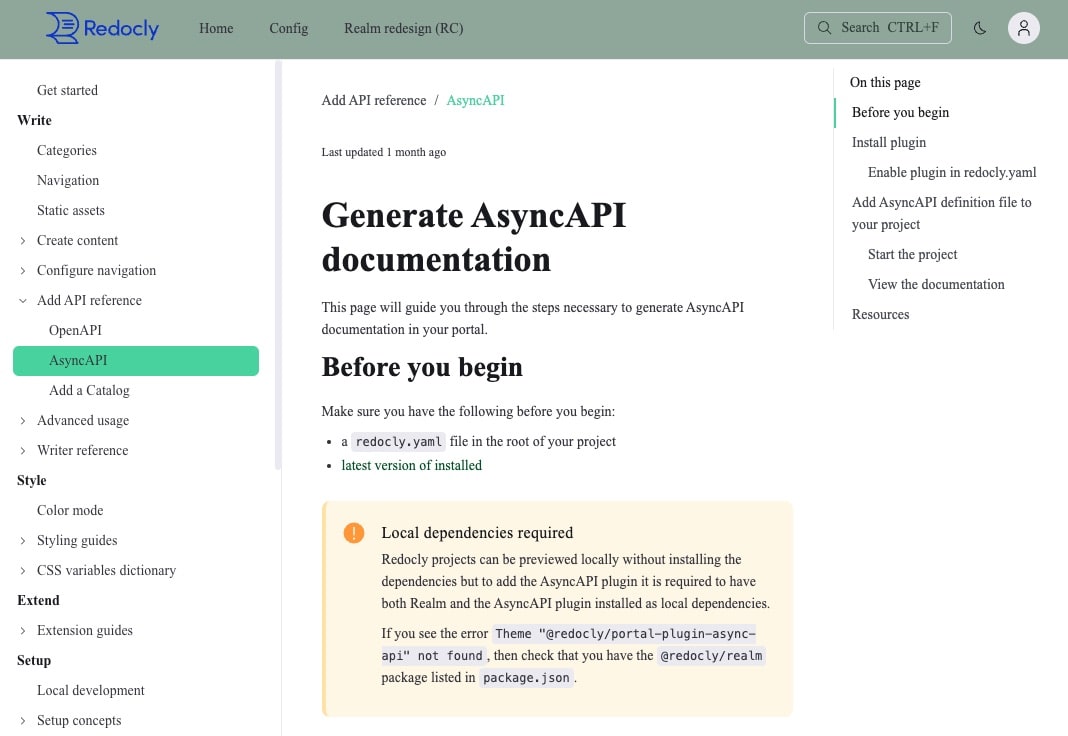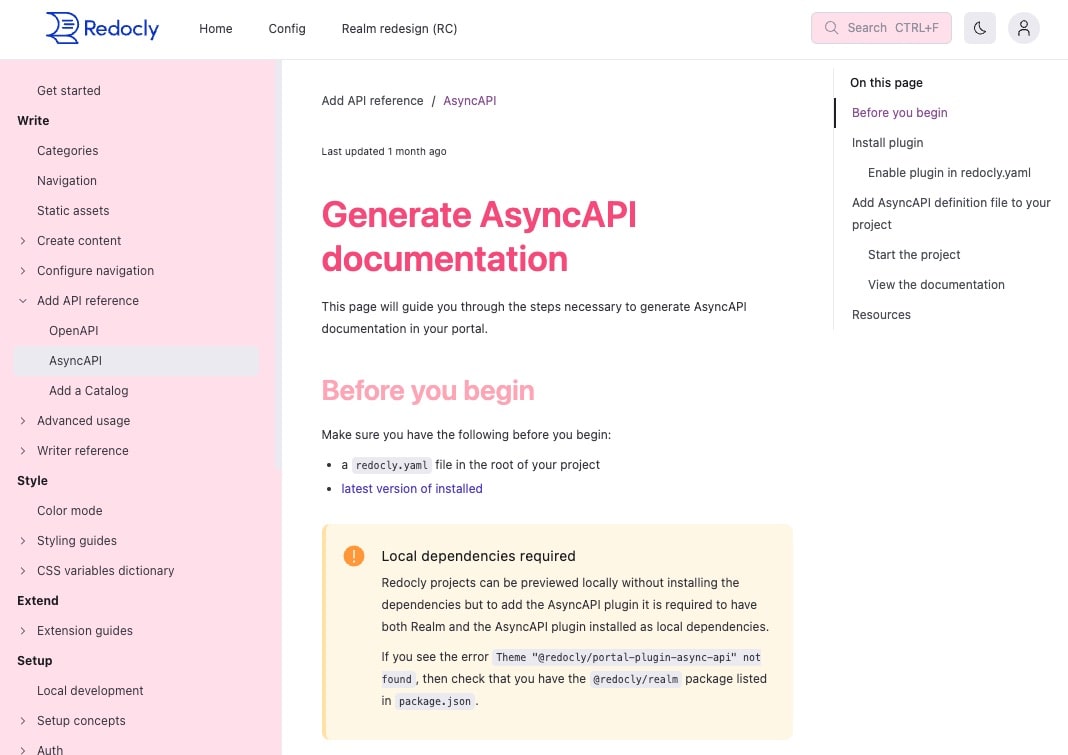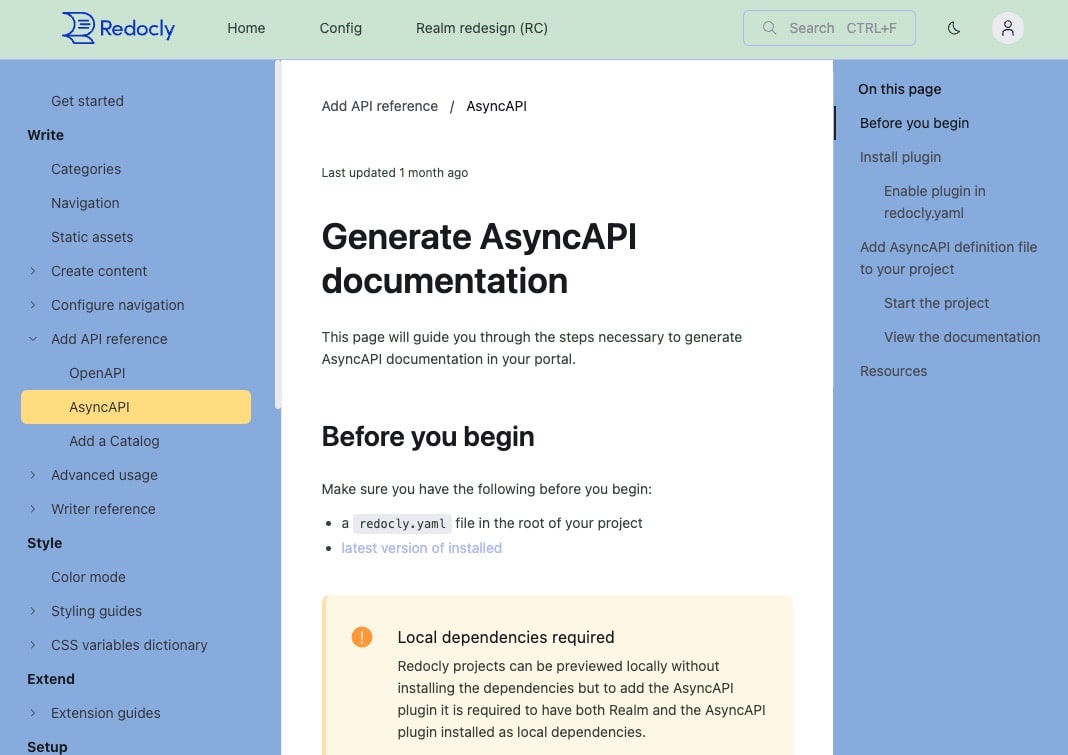You can apply custom styling to change the appearance of your project. For example, things like typography, colors, and spacing.
The core theme is built using CSS variables. You can override those variables to add custom styling while benefiting from the theme's existing structure.
You need a @theme/styles.css file to customize the styling of your project.
To add a @theme/styles.css file to your project:
- Add a folder named
@themeto the root of your project. - Create a
styles.cssfile inside the@themefolder.
Your project structure should look similar to the following example file tree:
your-awesome-project/
├──@theme/
│ └──styles.css
├──other-content.md
├──redocly.yaml
└──sidebars.yamlAdd custom styling to your project by overriding CSS variables in your @theme/styles.css file. The following example shows a complete custom styling setup:
/* Light mode styling (default) */
:root {
/* Brand colors */
--color-primary: #2563eb;
--color-primary-hover: #1d4ed8;
/* Layout colors */
--navbar-bg-color: #ffffff;
--sidebar-background-color: #f8fafc;
--content-background-color: #ffffff;
/* Typography */
--h1-text-color: #1f2937;
--text-color: #374151;
--link-text-color: #2563eb;
/* Spacing and borders */
--border-color: #e5e7eb;
--spacing-unit: 1rem;
}
/* Dark mode styling */
:root.dark {
/* Brand colors for dark mode */
--color-primary: #60a5fa;
--color-primary-hover: #3b82f6;
/* Layout colors */
--navbar-bg-color: #0f172a;
--sidebar-background-color: #1e293b;
--content-background-color: #0f172a;
/* Typography */
--h1-text-color: #f1f5f9;
--text-color: #cbd5e1;
--link-text-color: #60a5fa;
/* Spacing and borders */
--border-color: #374151;
}
/* Custom font configuration */
@font-face {
font-family: 'CustomBrand';
src: url('../static/fonts/custom-brand.woff2') format('woff2');
font-weight: 400;
font-display: swap;
}
:root {
--font-family-headings: 'CustomBrand', system-ui, sans-serif;
--font-family-body: 'Inter', system-ui, sans-serif;
}When you save this file and run your project in development mode, the styling changes will be visible immediately. Toggle between color modes to see the differences.
Steps for customizing your project styling:
- Choose elements to style - Identify which components or sections you want to customize (see table styling or font customization for specific guides)
- Find the CSS variables - Use browser developer tools or the CSS variables reference to identify the relevant variables
- Override variables - Add your custom values to the
@theme/styles.cssfile - Test in both modes - Ensure your styling works well in both light and dark modes using color mode customization
When your project has multiple products configured, a product-specific CSS class is automatically added to the root element (<html>) based on the current product. You can use this class to apply different styling to each product within the same project.
The product class follows the format product-{product-name}, where the product name is converted to kebab-case (lowercase with hyphens).
For example:
- Product name "Example One" becomes the class
product-example-one. - Product name "API Documentation" becomes the class
product-api-documentation.
To style a specific product, use the product class selector in your @theme/styles.css file:
/* Default styling for all products */
:root {
--navbar-bg-color: #ffffff;
--navbar-text-color: #1f2937;
}
/* Product-specific styling for "Example One" */
:root.product-example-one {
--navbar-bg-color: #e3f2fd;
--navbar-border-color: #2196f3;
--navbar-text-color: #1976d2;
}
/* Product-specific styling for "Example Two" */
:root.product-example-two {
--navbar-bg-color: #f3e5f5;
--navbar-border-color: #9c27b0;
--navbar-text-color: #7b1fa2;
}
/* Combine product classes with dark mode */
:root.dark.product-example-one {
--navbar-bg-color: #0d47a1;
--navbar-border-color: #42a5f5;
--navbar-text-color: #90caf9;
}
:root.dark.product-example-two {
--navbar-bg-color: #4a148c;
--navbar-border-color: #ba68c8;
--navbar-text-color: #ce93d8;
}Tips for product-specific styling:
- Find the product class name - use browser developer tools to inspect the
<html>element and see which product class is currently applied. - Combine with color modes - use
:root.dark.product-{product-name}to style products differently in dark mode. - Override CSS variables - product-specific styles work best when overriding CSS variables, allowing the theme to handle the rest.
- Test all products - make sure to test your styling across all products in your project to ensure consistency.
You can apply custom CSS classes or IDs included in your styles.css file to many Markdown or Markdoc block level elements such as table cells, list items, quotes, and headers using Markdoc annotation syntax.
To apply a custom class to a Markdown element:
Add the custom class to your
styles.cssfile, as in the following example:styles.css.highlight, p:has(.highlight) { background-color: yellow; color: red; }Add the annotation syntax to the element in the Markdown document, as in the following example:
lists.mdIntroduction to unordered list: - unordered list item 1 - unordered list item 2 {% class="highlight" %} - unordered list item 3 Introduction to ordered list: {% class="highlight" %} 1. ordered list item 1 1. ordered list item 2 1. ordered list item 3Rendered output:
Introduction to unordered list:
- unordered list item 1
- unordered list item 2
- unordered list item 3
Introduction to ordered list:
- ordered list item 1
- ordered list item 2
- ordered list item 3
You may need to restart the Webview or commit your changes to your branch to see the updates.
Use the examples in this section as starter themes to quickly add styling to your project.
Have a request for a styling example? Please use the feedback form at the bottom of the page and tell us.
The "Full corporate" styling uses a business font, has teal accents, and is very deliberate about spacing.
:root {
--teal-primary-1: #62D7A6;
--teal-primary-2: #9BB0A5;
--dark-green-primary-1: #384B42;
--dark-green-primary-2: #005A23;
--font-family-base: Times New Roman;
--md-container-max-width: 860px;
--md-container-padding-vertical: 18px;
--md-container-padding-horizontal: 5px;
--md-paragraph-margin-vertical: 6px;
--h1-margin-top: 12px;
--h2-margin-top: 8px;
--menu-item-bg-color-active: var(--teal-primary-1);
--toc-item-border-color-active: var(--teal-primary-1);
--breadcrumbs-text-color-active: var(--teal-primary-1);
--navbar-bg-color: var(--teal-primary-2);
--search-trigger-color: var(--dark-green-primary-1);
--link-color-primary: var(--teal-primary-1);
--link-color-visited: var(--dark-green-primary-2);
}
:root.dark {
--teal-primary-dark: #CDFBE4;
--text-color-dark: #22232B;
--navbar-text-color: #364133;
--menu-item-color-active: var(--text-color-dark);
--menu-item-text-color: var(--teal-primary-dark);
}The following screenshots show the styling rules applied:

The styling for the "Trendy startup" example combines shocking pink and teeny tiny font sizes. Note the increased specificity used to style .menu-item-type-separator in dark mode. This approach can be used for styling elements that may not have a CSS variable defined yet.
:root {
--font-size-base: 12px;
--font-size-sm: 10px;
--font-size-lg: 14px;
--font-size-xl: 20px;
--pink-primary-1: #F15483;
--pink-primary-2: #FAAEBD;
--pink-primary-3: #FFE3ED;
--purple-primary: #905B9F;
--h1-text-color: var(--pink-primary-1);
--heading-text-color: var(--pink-primary-2);
--search-trigger-bg-color: var(--pink-primary-3);
--sidebar-bg-color: var(--pink-primary-3);
--toc-item-text-color-active: var(--purple-primary);
--breadcrumbs-text-color-active: var(--purple-primary);
}
:root.dark {
--purple-primary-dark: #BD9BF4;
--menu-item-text-color: #22232B;
--toc-item-text-color-active: var(--purple-primary-dark);
--breadcrumbs-text-color-active: var(--purple-primary-dark);
}
:root.dark .menu-item-type-separator {
--menu-item-text-color: #22232B;
}The following screenshots show the styling rules applied:

The "Personal wellness" example uses styling that emphasizes pastel colors and lots of space between elements. Note that the only spacing change in the following example is for --spacing-unit, but space between elements is increased throughout the theme.
:root {
--pastel-green: #d2e7d6;
--pastel-green-secondary: #00A84E;
--pastel-blue: #94B5E3;
--pastel-purple: #B9C3FC;
--pastel-active: #FFDF82;
--text-color-dark-green: #3B4A3F;
--navbar-bg-color: var(--pastel-green);
--navbar-item-bg-color-hover: var(--pastel-active);
--navbar-item-bg-color-active: var(--pastel-active);
--navbar-border-color: var(--pastel-purple);
--search-trigger-border-color: var(--pastel-purple);
--search-input-placeholder-color: var(--pastel-purple);
--sidebar-bg-color: var(--pastel-blue);
--menu-item-bg-color-hover: var(--pastel-active);
--menu-item-bg-color-active: var(--pastel-active);
--toc-bg-color: var(--pastel-blue);
--toc-border-color: var(--pastel-purple);
--text-color-secondary: var(--text-color-dark-green);
--link-color-primary: var(--pastel-green-secondary);
--link-color-visited: var(--pastel-purple);
--spacing-unit: 6px;
}
:root.dark {
--pastel-green-dark: #728576;
--pastel-green-secondary: #00A84E;
--pastel-blue-dark: #2F4858;
--pastel-purple: #B9C3FC;
--pastel-active-dark: #386C5F;
--text-color-light-grey: #ECFEEF;
--navbar-bg-color: var(--pastel-green-dark);
--navbar-item-text-color-active: var(--pastel-green-dark);
--navbar-item-text-color-hover: var(--pastel-green-dark);
--navbar-item-bg-color-hover: var(--pastel-green);
--navbar-item-bg-color-active: var(--pastel-green);
--sidebar-bg-color: var(--pastel-blue-dark);
--menu-item-color-active: var(--pastel-green-dark);
--menu-item-color-hover: var(--pastel-green-dark);
--menu-item-bg-color-active: var(--pastel-green);
--menu-item-bg-color-hover: var(--pastel-green);
--toc-bg-color: var(--pastel-blue-dark);
--text-color-secondary: var(--text-color-light-grey);
}The following screenshots show the styling rules applied:

- Color mode customization - Create custom styling for light and dark modes with mode-specific color schemes and advanced CSS rules
- Branding overview - Explore all available branding and customization approaches from basic configuration to advanced component ejection
- Color mode concepts - Understand how the color mode feature works and its CSS variable-based implementation
- CSS variables reference - Complete dictionary of available CSS variables for comprehensive styling customization